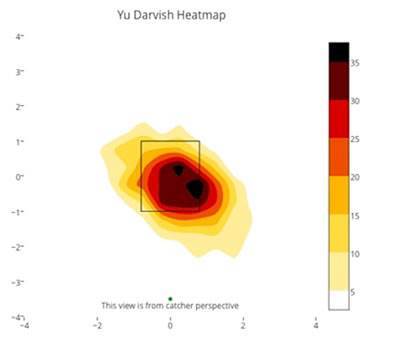
By Steve Cavolick
When the Chicago Cubs signed Yu Darvish to a 6-year, $126 million contract, they thought they were getting a dominant starter who would baffle hitters with his slider and solidify their rotation. Instead, they have a pitcher who has a 4.95 ERA and has more trips to the disabled list (2) than wins (1).
So what’s wrong with Yu? Analytics allowed the Cubs to discover some very interesting information about his wipeout pitch, the slider. Let’s start with location. The graphics below (courtesy of www.cubsinsider.com ) show placement as one problem. Last year, his slider was thrown so that it ended up being an outside pitch moving away from right-handed batters. This year, that pitch is being thrown more to the inside part of the strike zone, making it more hittable.
 |
 |
| 2017 |
2018 |
Being able to track pitch movement, arm slot, and release point information for his slider also showed the pitch just isn’t moving horizontally and vertically as much as last year:
Add it all up, and you get a pitch that is being hit twice as often as it has been in past years. Is the reason the reason for the changes in Yu’s pitch mechanical? Mental? Only he and the team know. This still isn’t fixed, but at least now the root cause of the problem is understood and can be remedied.
Without strong analytics, the team would not have been able to pinpoint the issue. This also brings to light some rules and best practices about how to create an organization that best utilizes data to solve business problems:
Create An Analytics-Driven Organization From The Top, Not The Bottom
When corporate leadership understands the value of analytics and competing on insights, the company ensures that employees focus initiatives, organization building, and staff training in this area. This leads to the democratization of data and the insights that come from it. The more eyes on the data looking for areas to improve, the better it is for the company.
Examine All Aspects Of The Business and Measure Everything
Any piece of data worth capturing can be made into a Key Performance Indicator, whether it is a baseball pitcher’s arm slot or the number or prescribed procedures by a physician in healthcare. One of our customers in the gaming industry tracked dollars spent by game and patron, and crowd movement via digital video analytics in order to create the most profitable casino floor layouts.
Continually Look For Additional, Useful Data
Data drives insights, but what you have in your ERP and other applications may not be enough to create better business results. Continually look at outside data sources to augment the information you already have. A retailer of aftermarket motorcycle parts learned that sales go up during inclement weather. They now integrate weather data with sales forecasts to optimize the future inventory in their distribution centers.
Build Partnerships Where You Lack Expertise
There is no reason to do this by yourself. Do you own all of your data? Do you have all the talent you need on staff to create an enterprise-class analytics environment? Analytics consultancies like LRS can help you design your analytics strategy, understand the value of solving a business problem with analytics, make product recommendations, and implement those solutions.
Using these principles, you and trusted partners, such as LRS, can use your data and analytics to solve your most challenging business problems.
The LRS Big Data and Analytics team has 20 years of experience in analytics, data warehousing, and information management across most verticals. If you are interested in understanding how we can help you find value in your data to create a competitive advantage, please fill out the form below and let us know how we can help.
About the author
Steve Cavolick is a Senior Solution Architect with LRS IT Solutions. With over 20 years of experience in enterprise business analytics and information management, Steve is 100% focused on helping customers find value in their data to drive better business outcomes. Using technologies from best-of-breed vendors, he has created solutions for the retail, telco, manufacturing, distribution, financial services, gaming, and insurance industries.